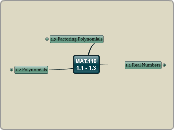MAT.116
1.1 - 1.3
1.2 Polynomials
Order of Operations
GEMDAS
G
E
MD
AS
Multiplying Polynomials
May require multiple uses of the distributive law.
Special Products
In the text, see Table 6.
Adding and Subtracting Polynomials
First remove parentheses and then combine like terms.
Write the result in order of decreasing degree from left to right.
Polynomials
A polynomial in x is an expression of the form
a_n*x^n + a_(n-1)*x^(n-1) + . . . + a_1*x + a_0
where n is a nonnegative integer (whole number) and a_0, a_1, . . . , a_n are real numbers with a_n not zero.
Related Vocabulary
variable
domain of the variable
constant
algebraic expressions
terms
coefficients
leading coefficient
degree
monomial
binomial
trinomial
constant polynomial
zero polynomial
degree of a term
degree of the polynomial
Exponents
If a is a real number and n is a natural number, then
a^n = a*a*a* . . . *a.
The natural number n is called the exponent and the real number a is called the base.
Property
a^m * a^n = a^(m+n)
1.3 Factoring Polynomials
Other Methods
There is a more mechanical method that can be used in place of the trial-and-error method for quadratic polynomials with leading coefficient not 1 and linear coefficient not 0.
There are also graphical techniques for finding factorizations. These involve treating the polynomial as a function, graphing it, and looking for the zeros of the function (also known as the x-intercepts or roots).
Factoring by Regrouping
Sometimes when a polynomial has four terms it is possible to factor the terms in pairs and find a common factor to each pair. Then the distributive law can be used to finish the factoring process.
Trial-and-Error Factorization
For quadratic polynomials of the form x^2 + bx + c, where b is not 0, we can factor by finding two factors for c which sum to b.
Leading Coefficient Not 1
For quadratic polynomials of the form ax^2 + bx + c, where a and b are not 0, we can factor using a trial-and-error method.
First, choose an integer factorization for the leading coefficient a. For example, let pq = a be such a factorization.
Then, if our factorization of a is correct, we know that the factored form must look like (px + r)(qx + s), where rs = c. We try different values for r and s to see if we can find a combination, along with p and q, that end up giving b for the coefficient of the middle term.
If no such combination of r and s can be found, we choose a different factorization for the leading coefficient a and repeat the process.
If, after trying all possible combinations of p and q values with all possible combinations of r and s values a factorization is never found, it can be stated that the polynomial is prime (over the integers).
Leading Coefficient 1
Some Important Formulas
Difference of Two Squares
Pefect Square Trinomial
In the text, see Table 7.
Don't worry about the cube formulas.
Common Factors
The first step whenever factoring a polynomial is to factor out the greatest common factor from all of the terms.
Factoring
Expressing a polynomial as a product of two (or more) polynomials, each of lesser degree than the original polynomial.
A polynomial is completely factored (over the set of integers) if it is expressed as a product of prime polynomials with integral coefficients.
NOTE: The text's author has chosen to limit factoring to the set of integers. It is also possible, though considerably more difficult, to factor over the set of rational numbers, or even over the set of real numbers.
1.1 Real Numbers
Operations with Real Numbers
Properties of Quotients (including Fractions)
In the text, see Table 5.
Properties Involving Zero
In the text, see Table 4.
Properties of Negatives
In the text, see Table 3.
Rules of Operation
Distributive Law
In the text, see Table 2.
Multiplication Rules
Addition Rules
Commutative Law
Associative Law
Identity Law
Inverse Law
In the text, see Table 2.
Representing Real Numbers on a Number Line
Number Line
A (usually) horizontal straight line.One point represents the number 0, or the origin.A number to the right of 0 represents positive 1.The distance between 0 and 1 sets a scale.Points representing positive numbers lie an appropriate distance to the right of 0.Points representing negative numbers lie an appropriate distance to the left of 0.For every real number there is exactly one corresponding point on the number line (one-to-one correspondence).
The Set of Real Numbers / Representing Real Numbers as Decimals
All rational and all irrational numbers taken together as a single set.
Any value you can find on a number line.
Irrational Numbers
Numbers that cannot be expressed as a ratio of two integers.
Decimal expansions are nonterminating, nonrepeating.
Rational Numbers
Numbers of the form a/b where a and b are integers and b is not zero.
Decimal expansions are either terminating or repeating nonterminating.
Integers
{ . . . , -3, -2, -1, 0, 1, 2, 3, . . . }
Whole Numbers
{ 0, 1, 2, 3, . . . }
Natural Numbers
{ 1, 2, 3, . . . }









